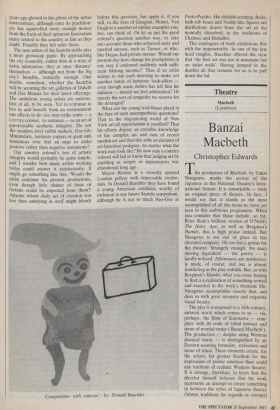Exhibitions
NY Art Now
(Saatchi Gallery, till February)
Donald Baechler (Mayor Rowan, till 2 October)
Confounded chic
Giles Auty
Within radical art circles in Britain, the standard figure of fun is the country colonel. Anyone who seeks to be taken seriously is at pains never to make the sort of remarks this mythic militarist might utter. With limited knowledge of America, I cannot confirm that the colonel has an exact transatlantic counterpart. I imagine he does simply because young radicals everywhere enjoy the illusion that they are shocking somebody. Outrageousness needs a yardstick by which to judge itself.
Whoever the favoured American philistine-figure may be, one suspects he might not care too much for the recent productions of youngish artists now on view at the Saatchi Gallery (98A Boundary Road, NW8), nor for those of Donald Baechler at Mayor Rowan (31A Bruton Place, W1). Such artists will undoubtedly see in this a vindication of their aesthetic stances. Being disapproved of gives them an illusion of belonging to an exclusive club with famous former members.
At the Saatchi Gallery we may witness such unusual items as three new vacuum cleaners in a perspex tower, two basket- balls in a fish-tank, a selection of giant sinks and a stainless steel replica of a rabbit balloon. 'How droll,' murmurs the soph- isticate. 'What rubbish,' roars the colonel. These are not the only exhibits, of course, but merely some of the more sensational. Notoriety is the bastard child of fame. Are we able, any longer, to distinguish between them? The visual fare set before us at Charles and Doris Saatchi's showplace is the result of the couple's recent shopping spree among the galleries of New York's Lower East Side. Those who care for snazzy descriptions will be glad to know that this young, irreverent New York art has managed to get itself called 'Smart Art' and `Neo-Geo'. Its originators believe it is making ironic comment on consumer capi- talism by pirating some of its less likable productions: linen-finish laminates, brash company logos, Day-Glo colours. The world it comments on cynically is urban and claustrophobic, a community still be- lieving in a utopia realisable through tech- nology alone. In contrast, Pop Art of 25 years ago gloried in the glitter of the urban environment, although once its practition- ers has squirrelled away enough money from the fruits of their apparent fascination many retired to the country as fast as they could. Possibly they felt safer there.
The new artists of the Saatchi stable play a more grown-up game. By approaching the city ironically, rather than in a state of naive infatuation, they at once 'distance' themselves — although not from the big city's benefits, naturally enough. One doubts, somehow, whether the Saatchis will be scouring the art galleries of Duluth and Des Moines for their latest offerings. The ambitious young artists are anxious, first of all, to be seem Yet to continue to live in and benefit from an environment one affects to despise may strike some — a country colonel, for instance — as an act of questionable aesthetic integrity. Do not the stainless steel rabbit makers, Day-Glo Minimalists. laminate copiers or giant sink simulators ever feel an urge to make positive rather than negative statements?
Our country colonel's test of artistic integrity would probably be quite simple, and I wonder how many artists working today could answer it satisfactorily. It might go something like this: 'Would the artist continue his present productions, even though little chance of fame or fortune could be expected from them?' Anyone whose daily act of creation was less than satisfying in itself might blench before this question, but apply it, if you will, to the lives of Gauguin, Monet, Van Gogh or a number of similar examples you, too, can think of. Or let us put the good colonel's question another way, to take into account those who achieved early and merited success, such as Turner, or who, like Degas, had private means: 'Would our present-day hero change his productions in any way if endowed suddenly with suffi- cient lifelong income?' Thus if an artist wishes to rise each morning to make yet another batch of laminate look-alikes even though uncle Jethro has left him his millions — should we feel admiration? Or merely the sort of sympathy we reserve for the deranged?
What can the young trail-blazer plead in the face of such unsympathetic questions? That in the dog-eat-dog world of New York art all opportunism is justified? That his efforts display an enviable knowledge of the complex ins and outs of recent modish art and that this adds an element of art-historical pedigree, no matter what the work may look like? By now only a country colonel will fail to know that judging art by anything as simple as appearances was abandoned long ago.
Mayor Rowan is a recently opened London gallery with impeccable creden- tials. In Donald Baechler they have found a young American candidate worthy of inclusion in any future Saatchi symposium, although he is not so much Neo-Geo as 'Composition with suitcase', by Donald Baechler Proto-Psycho. His childish-seeming ducks, bath-tub boats and Noddy-like figures are distillations drawn from the art of the mentally disturbed, in the traditions of Chaissac and Dubuffet.
The catalogues of both exhibitions flirt with the impenetrable. In one of the few lucid insights, Baechler offered the view that 'the best art was not in museums but on toilet walls'. Having jumped in the dustbin all that remains for us is to pull down the lid.































































 Previous page
Previous page